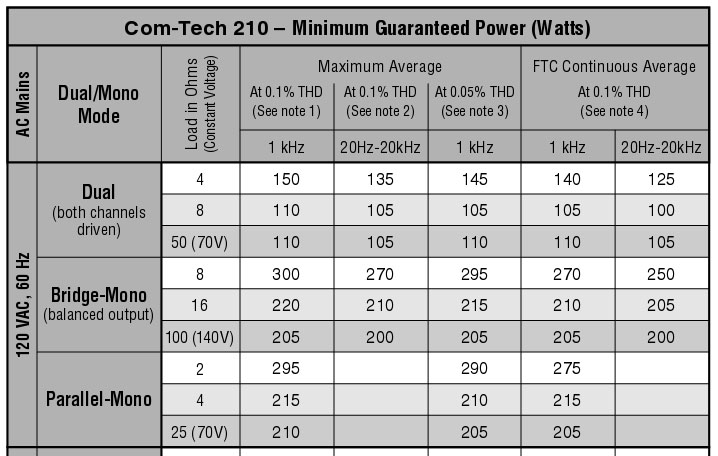Kreshna
...but I have to know.
Bridging seems to adversely affect an amplifier's capability to drive low impedance load. An amplifier rated to drive a 2 ohm stereo load (2 ohms on each channel) is only going to be able to drive a 4 ohm (or higher) bridge-mono load. A 2 ohm bridge-mono load will more than likely destroy the said amplifier.
An amplifier running in bridge-mono operation produces twice as much voltage across the load.
However, there is also parallel-mono operation, which produces twice the current instead of twice the voltage. An example of amplifier which can run in parallel-mono is Crown Com-Tech series, like Crown CT 210, Crown CT 410, and Crown CT 810.
On page 35, Crown Com-Tech series manual, there is table showing minimum guaranteed power for Crown Com-Tech 210. And indeed, the differences between dual channel, bridge-mono, and parallel-mono operation are apparent.

Minimum guaranteed power for Crown CT 210. Notice the load differences between dual channel, bridge-mono, and parallel-mono.
I can see parallel-mono being useful for hard-to-drive loudspeakers. For example, Bowers & Wilkins DM302 has impedance drop as low as 3 ohms between 200 Hz and 300 Hz.

B&W DM302 impedance curve.
So, my questions are: why aren't many amplifiers able to do parallel-mono operations? The only models I knew capable to perform parallel-mono operations are Crown Com-Tech series, while many other amps does not support such mode. For example, Crown XLS 1002 can only be bridged, but it cannot be paralleled.
What are the major downsides of parallel-mono, that keep many amplifiers from supporting such operation? Perhaps more distortions? Or perhaps such operation requires more difficult design and/or more expensive circuitry?
An amplifier running in bridge-mono operation produces twice as much voltage across the load.
However, there is also parallel-mono operation, which produces twice the current instead of twice the voltage. An example of amplifier which can run in parallel-mono is Crown Com-Tech series, like Crown CT 210, Crown CT 410, and Crown CT 810.
On page 35, Crown Com-Tech series manual, there is table showing minimum guaranteed power for Crown Com-Tech 210. And indeed, the differences between dual channel, bridge-mono, and parallel-mono operation are apparent.
- Dual channel has power figures for 4 ohms load and 8 ohms load.
- Bridge-mono has power figures for 8 ohms load and 16 ohms load.
- Parallel-mono has power figures for 2 ohms load and 4 ohms load.

Minimum guaranteed power for Crown CT 210. Notice the load differences between dual channel, bridge-mono, and parallel-mono.
I can see parallel-mono being useful for hard-to-drive loudspeakers. For example, Bowers & Wilkins DM302 has impedance drop as low as 3 ohms between 200 Hz and 300 Hz.

B&W DM302 impedance curve.
So, my questions are: why aren't many amplifiers able to do parallel-mono operations? The only models I knew capable to perform parallel-mono operations are Crown Com-Tech series, while many other amps does not support such mode. For example, Crown XLS 1002 can only be bridged, but it cannot be paralleled.
What are the major downsides of parallel-mono, that keep many amplifiers from supporting such operation? Perhaps more distortions? Or perhaps such operation requires more difficult design and/or more expensive circuitry?

